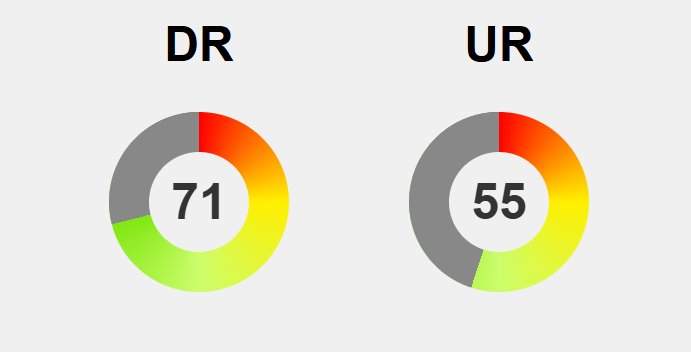Noticing a sudden drop in your Domain Rating (DR) can be bewildering—are your backlinks weakening, or is there a deeper shift at play? Ahrefs’ recent algorithm update aims for a more accurate reflection of genuine link authority by emphasizing quality, relevance, and trustworthiness over sheer volume. This recalibration doesn’t penalize; it recalibrates, highlighting the importance of authentic backlinks from reputable sources. But how should you respond? Instead of panic, view this as an opportunity to audit your backlink profile, remove low-value links, and focus on earning high-quality, niche-relevant backlinks through organic, content-driven strategies. This shift underscores a broader industry emphasis: genuine authority built on trust and relevance outweighs superficial metrics. Are you ready to adapt your SEO approach, prioritize meaningful relationships, and build resilience against future changes? Embracing these insights can turn sudden fluctuations into long-term growth—if you understand what’s truly driving your site’s authority.

Decoding Sudden DR Fluctuations: What Website Owners Need to Know
Recently, many website owners have noticed sudden shifts in their Domain Rating (DR) scores. These fluctuations can be confusing, especially when scores drop sharply without any clear reason, like losing backlinks or making content updates. As SEO metrics continue to evolve rapidly, such changes are becoming more common. This is partly due to ongoing updates in how tools like Ahrefs assess and measure backlink profiles, aiming to provide a clearer picture of a site’s true authority.
In September, Ahrefs introduced a major update to its DR algorithm. The goal was to enhance accuracy by refining how link quality, relevance, and trustworthiness are evaluated. Instead of relying mainly on the number of backlinks or their overall strength, the new system considers more nuanced factors. For example, it now better accounts for whether backlinks come from relevant, high-trust domains within a specific niche. This means that some sites might see their scores decrease even if their backlink profile hasn’t changed, while others could see an increase if they’ve built more authentic links.
These fluctuations aren’t isolated incidents; they reflect a broader effort to recalibrate the metric so it aligns more closely with actual authority. The update aims to create a fairer, more transparent way of measuring influence online. When your DR drops unexpectedly, it’s tempting to panic or assume you’ve been penalized. But more often, these changes are just the system adjusting to new data, emphasizing quality and relevance over sheer volume.
Understanding the reasons behind these shifts can help prevent unnecessary concern. Remember, DR is a relative metric—it compares your backlink profile to that of your competitors. When the industry landscape shifts due to algorithm updates, your score can change even if your backlink profile remains stable. This highlights the importance of regularly monitoring your backlinks and focusing on acquiring high-quality, relevant links rather than chasing superficial gains or quick fixes.
These updates serve as a reminder that metrics like DR are tools, not absolute measures of value. They reflect the evolving standards of link authority, not a fixed score. Instead of reacting emotionally to sudden drops, it’s smarter to see them as opportunities to evaluate and improve your backlink profile. Prioritizing authentic, niche-relevant backlinks and creating valuable content that attracts links naturally will help you adapt and thrive in this new environment.
How Ahrefs’ New Algorithm Reframes Domain Rating Calculation
Recently, Ahrefs overhauled its approach to calculating Domain Rating, aiming for a more precise reflection of a website’s true backlink strength. Instead of primarily counting the number of backlinks or relying on their overall strength, the new system emphasizes the quality, relevance, and trustworthiness of those links. This shift means that not all backlinks are weighted equally; instead, links from reputable, high-authority domains within your niche now carry more weight, while superficial or spammy links are de-emphasized.
The update involves a deeper analysis of the linking domains themselves. Ahrefs now assesses each domain’s backlink profile, checking for signs of spam, overall health, and trust signals. Domains with a strong backlink profile, relevant content, and good reputation are now considered more valuable, helping the algorithm distinguish genuine authority from manipulative tactics. This move aligns the metric more closely with how search engines evaluate trust and relevance, pushing SEO practices toward more authentic link-building.
Link placement and context have also gained importance in the recalibrated system. High-quality backlinks embedded naturally within relevant content are valued more than links that appear out of place or are placed in spammy environments. This encourages a focus on editorial relevance and content quality, rewarding efforts that build links organically rather than through shortcuts or artificial schemes. The algorithm now looks at how links are integrated into the overall content ecosystem, emphasizing editorial integrity.
Another key aspect of this update is how Ahrefs weights backlinks across a profile. Previously, the focus was mainly on the number and strength of links, which sometimes inflated scores for sites relying on volume rather than quality. The new system emphasizes a balanced approach, where a few high-quality, niche-relevant links can significantly boost your DR, whereas superficial links have less impact. This encourages sustainable strategies that prioritize long-term authority over quick, superficial gains.
Importantly, this recalibration isn’t designed to penalize websites but to improve accuracy. When your DR drops, it’s often a sign that the system is now better at measuring your actual backlink profile, not that your site has lost influence. By refining how relevance, trust, and quality are factored in, Ahrefs aims to provide a fairer, more transparent metric that truly reflects your site’s authority in the current SEO landscape.
Overall, this update marks a move toward a more sophisticated understanding of link quality, aligning with broader SEO trends that prioritize trust and relevance. It’s a reminder that building genuine, high-quality backlinks from reputable sources is more important than ever. Adapting your strategy to focus on authentic relationships and content-driven link-building will help you stay ahead as these recalibrations continue to evolve the standards of online authority.

Impacts of the DR Update: Rethinking Your SEO Strategy
The recalibration of Ahrefs’ Domain Rating fundamentally shifts how website owners and SEO professionals interpret their backlink profiles. Instead of viewing DR as a straightforward measure of influence, it now acts more like a mirror reflecting the true quality, relevance, and trustworthiness of your links. A sudden drop in your score doesn’t automatically signal a penalty or loss of authority; it often indicates that the new system is better at measuring genuine link quality, prompting a reassessment of your backlink strategy.
This update highlights the importance of regular backlink audits. When your DR dips unexpectedly, it’s a sign to scrutinize your backlink profile for low-trust or spammy links that may be dragging your score down. Conversely, it’s a chance to identify and strengthen relationships with reputable, high-authority sites within your niche. Building a profile rooted in real relevance and trust not only helps recover from fluctuations but also prepares you for future algorithm updates.
For SEO professionals, these changes reinforce the need to move away from superficial link-building tactics. Instead, focus on organic outreach, guest posting, and creating content that naturally attracts high-quality backlinks. The emphasis on relevance and trustworthiness means that earning links from niche-relevant sites will have a far more positive impact on your DR and overall authority than chasing volume or shortcuts. This approach aligns with broader search engine trends that prioritize authentic signals over manipulative strategies.
Fluctuations in DR following the update shouldn’t be viewed as setbacks but as opportunities to refine your SEO approach. They serve as a reminder that sustainable growth depends on building a credible, trustworthy backlink profile. By consistently earning links from reputable sources and producing valuable content, you can enhance your site’s authority in a way that’s aligned with the new standards of transparency and quality. Over time, this focus on authenticity will lead to more stable, long-term rankings.
Ultimately, the DR update underscores a broader industry shift toward valuing trust and relevance above superficial metrics. It encourages everyone in the SEO space to prioritize meaningful relationships, high-quality content, and genuine authority signals. Embracing this mindset not only helps you weather short-term fluctuations but also positions your site for sustainable success in an increasingly transparent digital landscape. Building real influence today means focusing on integrity, relevance, and long-term value.
Understanding how the recent changes affect your backlink profile can also help you respond effectively to a drastic drop in DR. By analyzing these fluctuations, you can identify which links may have lost trustworthiness and take steps to rebuild a stronger, more authentic backlink foundation that aligns with the updated metrics.
Strategic Steps to Recover and Boost Your Domain Authority
To recover from a dip in your Domain Rating, start with a thorough backlink audit. Use tools like Ahrefs to identify which links have been lost or devalued, paying close attention to any sudden removals of high-quality, relevant backlinks. Look for low-trust or spammy links that may have appeared or increased, and remove or disavow them to clean up your profile. This step helps you understand where your backlink strength has weakened and sets the foundation for targeted improvement.
Next, focus on rebuilding your backlink profile with an emphasis on quality over quantity. Reach out to reputable, niche-relevant sites within your industry for guest posting, collaborations, or content exchanges. Creating valuable, shareable content—such as comprehensive guides, original research, or engaging infographics—can naturally attract high-quality backlinks. Remember, a single authoritative link from a trusted source often has more impact than multiple superficial ones, so prioritize meaningful relationships that bolster your credibility.
Consistently monitor your referring domains and their authority. Keep an eye on their DR and overall quality, and engage with site owners or editors to strengthen connections. If key sites have lost links or their authority has declined, consider outreach campaigns to restore or reinforce those relationships. Regular oversight ensures your backlink profile remains aligned with the latest standards, helping you prevent further declines and build resilience against future fluctuations.
Avoid shortcuts like buying links or participating in spammy schemes, which can harm your long-term growth. Instead, adopt a steady, organic approach centered on authentic outreach and content creation. Building trust and authority takes time, but these sustainable tactics will establish a foundation that withstands algorithm updates and industry shifts. Patience and consistency are your best tools for restoring and enhancing your DR over the long haul.
Treat fluctuations not as setbacks but as opportunities to refine your SEO strategy. Use them to identify weaknesses, remove low-value links, and focus on earning genuine, high-quality backlinks. By aligning your efforts with modern SEO principles—trust, relevance, and value—you set your site up for sustainable growth. Over time, this approach will not only recover your DR but also strengthen your overall online authority, making your site more resistant to future changes and more attractive to both users and search engines.

Long-Term SEO Success in the Wake of DR Recalibration
In light of Ahrefs’ recent DR recalibration, adopting a strategic, long-term mindset in SEO becomes more vital than ever. Instead of chasing quick wins or relying solely on superficial metrics, focus on building genuine, high-quality backlinks from reputable, relevant sources. Content remains your strongest asset—creating valuable, insightful material that naturally attracts links aligns perfectly with the new emphasis on relevance and trust. This approach not only helps weather fluctuations but also sets the foundation for sustainable growth.
Metrics like Domain Rating serve as useful benchmarks, but they only tell part of the story. Today’s SEO landscape rewards trustworthiness and relevance far more than inflated scores. A dip in DR after the update isn’t necessarily a loss of influence; it often reflects a more accurate picture of your site’s true authority. This shift encourages moving away from shortcuts and superficial tactics, focusing instead on cultivating real authority through meaningful relationships and high-value content.
Building a resilient backlink profile takes time and consistency. Prioritize earning links from reputable, niche-relevant sites, and avoid reliance on manipulative practices like buying links or participating in spammy schemes. Organic outreach, guest posting, and creating content that genuinely resonates with your audience will attract high-quality backlinks naturally. Over time, these efforts will not only restore your DR but also strengthen your site’s overall credibility and trustworthiness.
Use the recent fluctuations as opportunities to reevaluate your strategy. Regular backlink audits help identify and disavow low-quality or spammy links, while proactive outreach can reinforce valuable relationships. Focus on earning links that matter—those from authoritative, relevant sources—because these will have the most lasting impact on your authority and search performance. Patience and persistence in this process translate into long-term resilience against future algorithm changes.
In the end, these updates highlight a broader industry trend: genuine signals of trust and relevance matter more than ever. Embracing this reality means shifting your focus from superficial metrics to meaningful, ethical SEO practices. Building real influence today requires dedication to content quality, authentic relationships, and trust-building efforts that stand the test of time. This mindset positions your site for sustainable success in a landscape that values integrity over quick fixes.
By aligning your SEO approach with these principles, you create a foundation that withstands fluctuations and future updates. The goal is not just a higher DR but a stronger, more credible online presence that genuinely reflects your site’s authority. As the industry continues to evolve, staying committed to ethical, long-term strategies will keep you ahead, ensuring your efforts translate into lasting growth and visibility.








